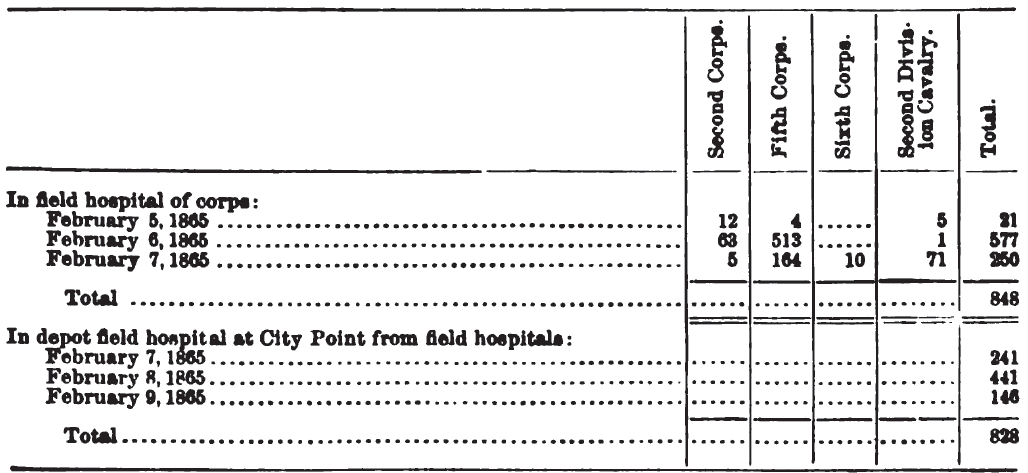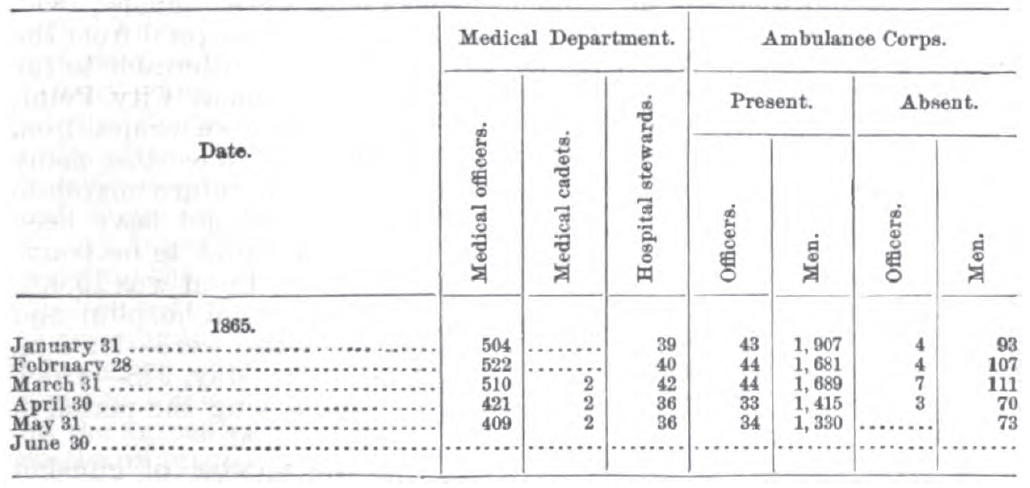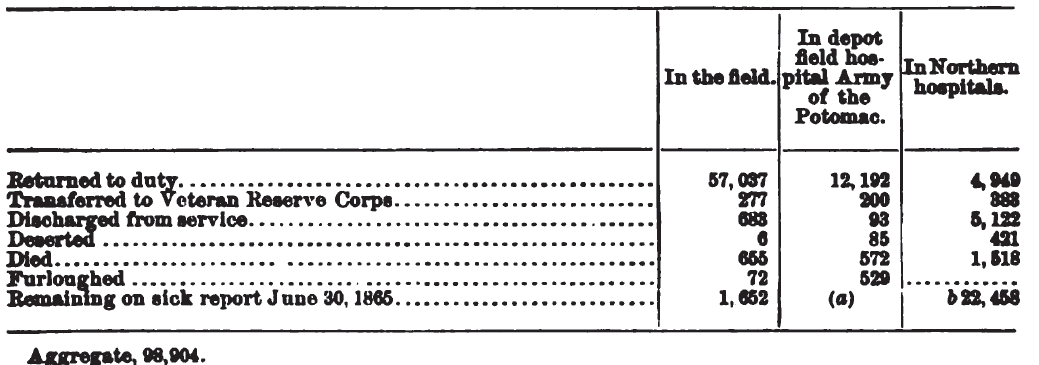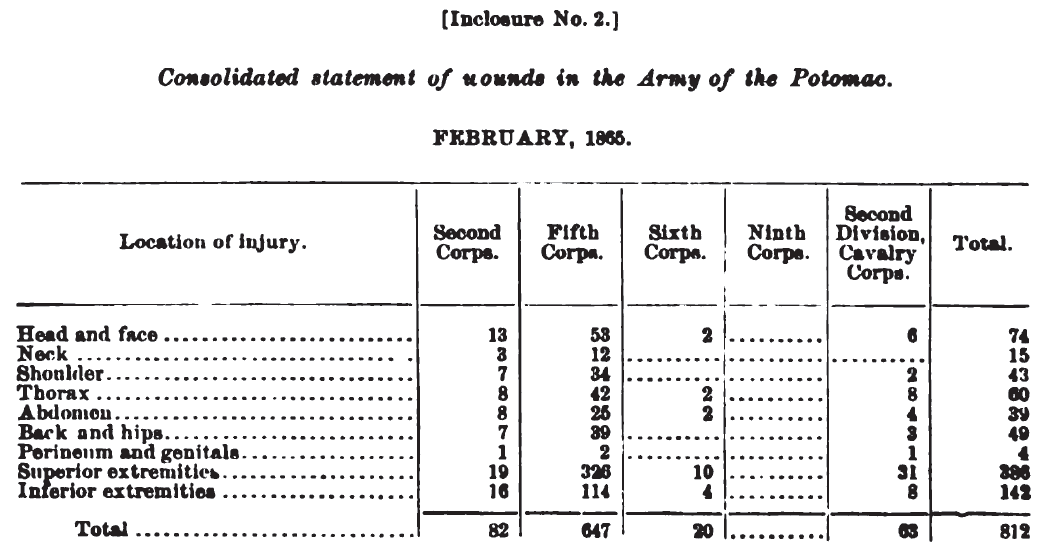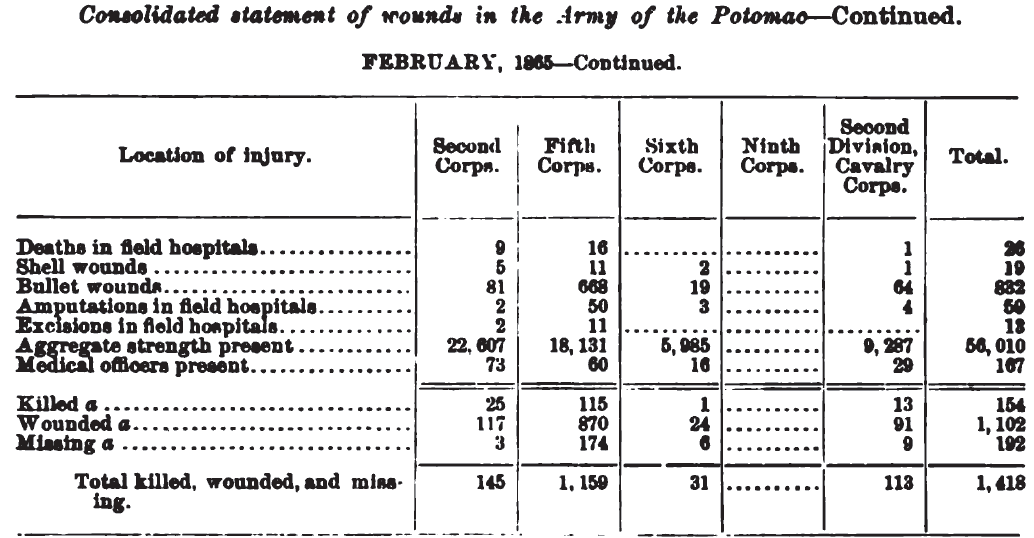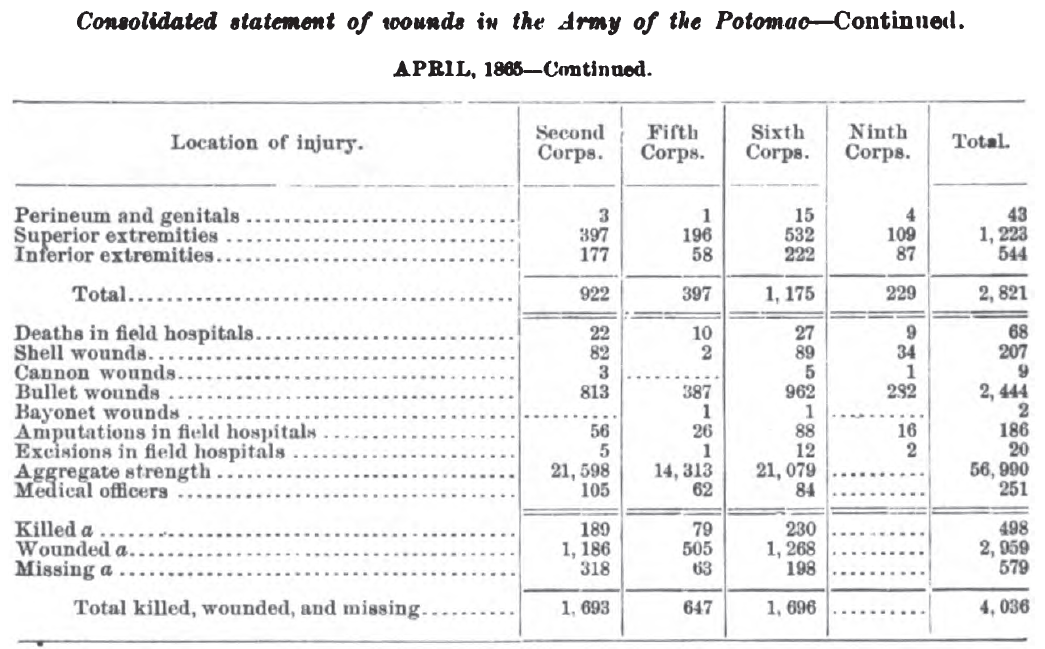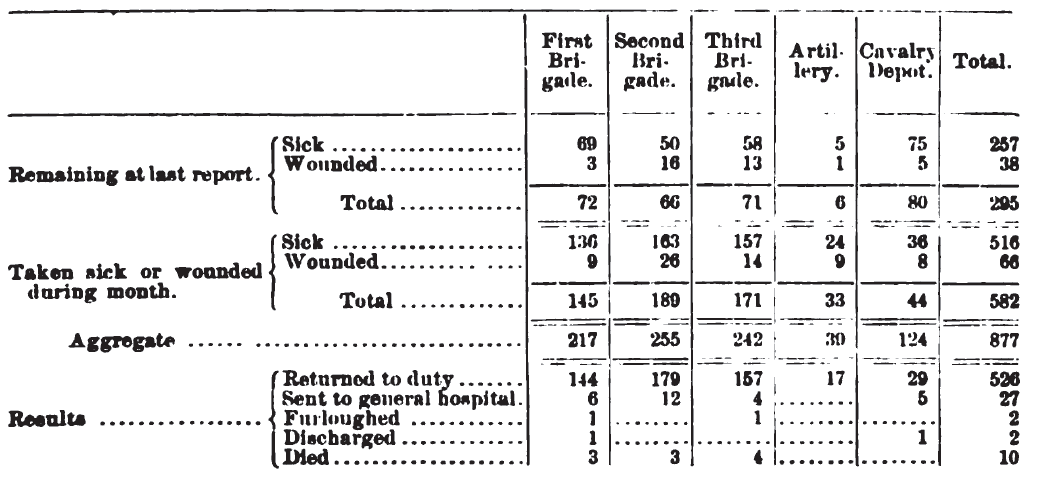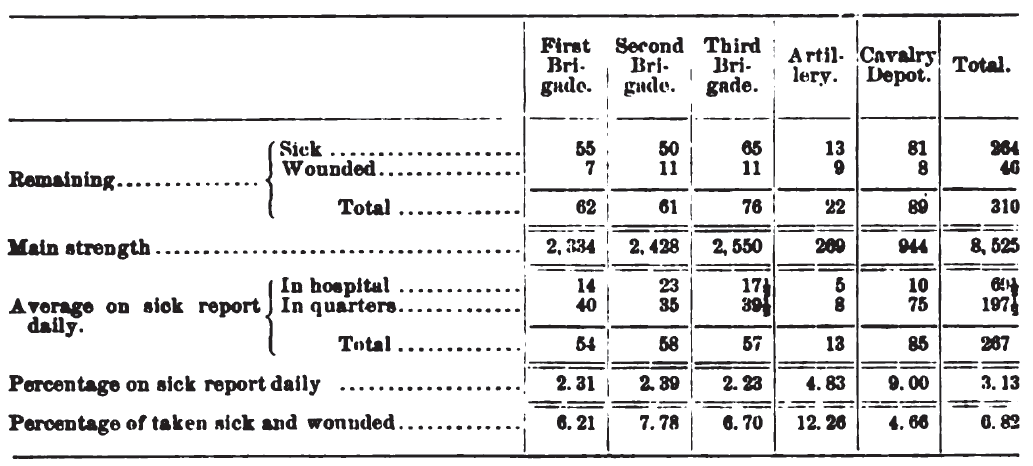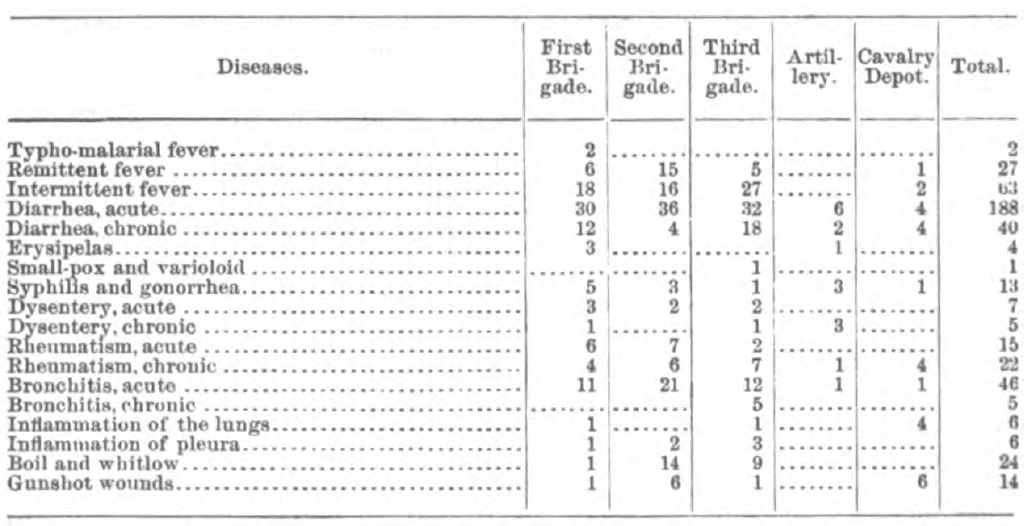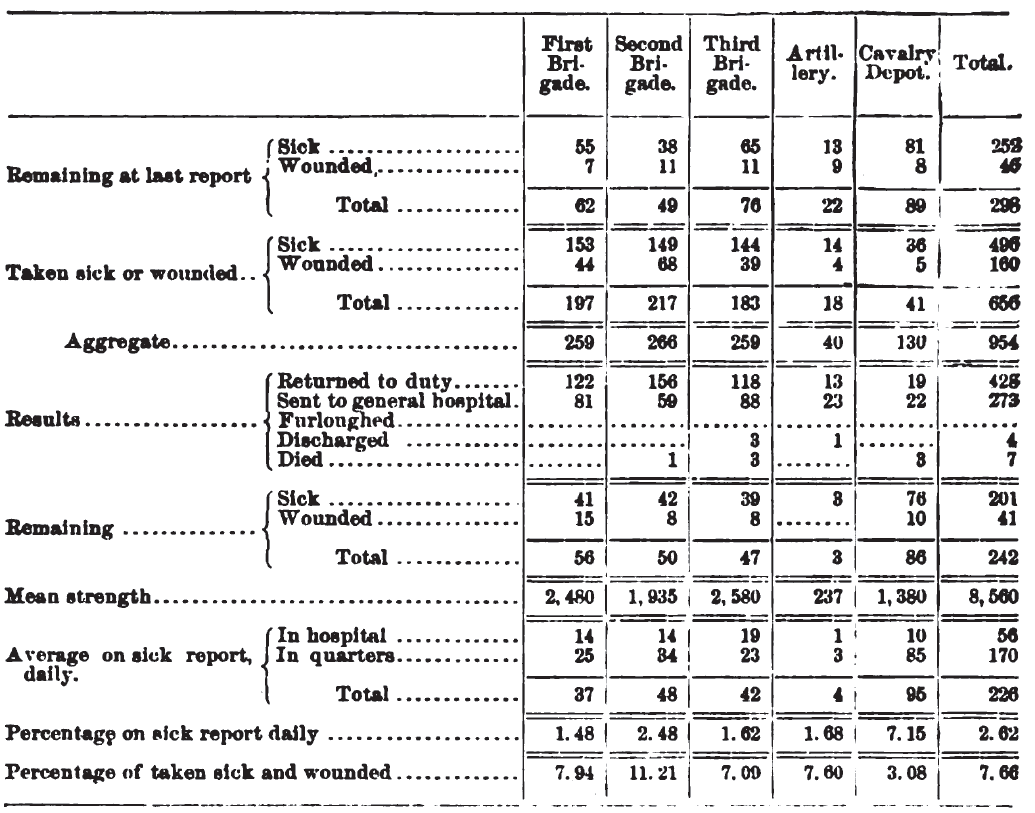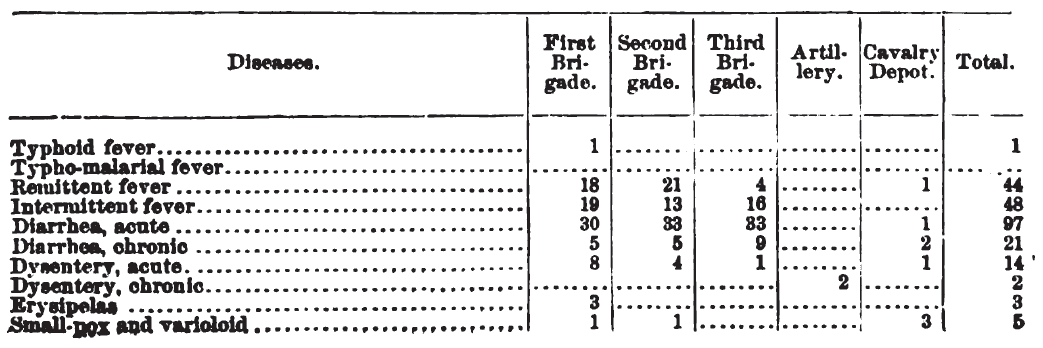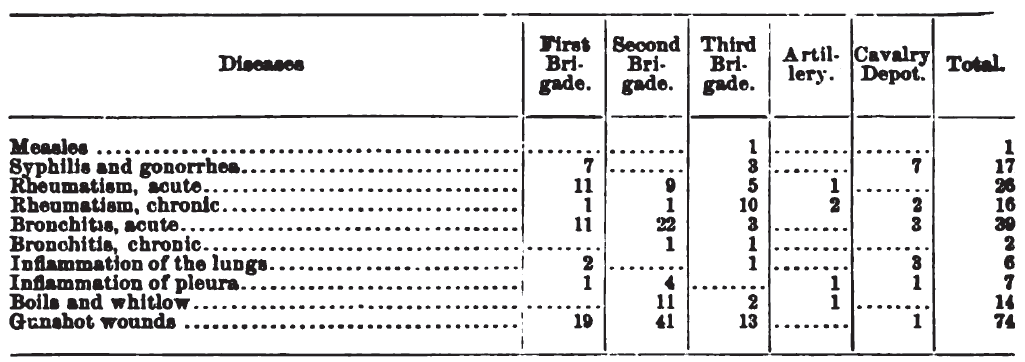No. 6. Report of Surg. Thomas A. McParlin, U. S. Army, Medical Director, of operations January 1 – June 30.1
No. 209 G STREET,
Washington, D. C., August 21, 1865.
GENERAL: I have the honor to submit tabular report of the sick and wounded of the Army of the Potomac from January 1, 1865, and other accompanying reports relative to the operations of the medical department since that period.
In January this army was composed of the Second, Fifth, Sixth, and Ninth Corps, the Second Cavalry Division, and independent commands, viz: Artillery Reserve, Provost-Marshal General’s Brigade, Engineer Brigade and Battalion, and Signal Corps. The troops were comfortably quartered for the season, so far as compatible with their duties and position in the lines and works investing Petersburg and confronting the Army of Northern Virginia. In the month no important movement occurred.
In December, 1864, the supply of fresh vegetables had ceased. This deprivation continued so long that in March the subject was brought to the attention of the commanding general.
April 29, the medical inspector, Second Corps, specially reported on the supply as inadequate to preserve a proper standard of health in the command, citing the prevalence of diarrhoea of an obstinate and exhausting character as attributable thereto.
January 13, recommendation was made that cooking by companies be enforced and attention be reinvited to existing orders requiring it.
Vide, General Orders, No. 52, headquarters Army of the Potomac, May 15, 1863.* It should be remarked that the deficiencies of fresh vegetables was attributed by the subsistence department to want of transportation.
The rebel fleet came down from Richmond to the lower end of fresh vegetables was attributed by the subsistence department to want of transportation.
The rebel fleet came down from Richmond to the lower end of Dutch Gap Canal January 24, but after suffering the loss of one of its vessels, exploded by a shell from our batteries on the right bank of the James River, the fleet steamed back.
I had taken measures from the original occupancy of the depot to have the supplies of the medical purveyor kept afloat and ready for movement should any contingency require it.
Preparations for a military operation were made early in February, and the clearance of the field hospitals and commands of men unable to participate in it became necessary. Over 2,000 were sent down to the Depot Field Hospital at City Point, in thirty-six hours, chiefly at night, the railroad conducting its ordinary business in the meantime.
On the 5th of February the movement to Dabney’s Mill and Hatcher’s Run began. The Second Cavalry Division, moving by Reams’ Station and Rowanty Creek, made a demonstration toward Dinwiddie Court-House, but returned back by Rowanty and the Boydton and Vaughan roads, and guarded the extreme left of our line, which had been advanced by the Second Corps and extended by the Fifth Corps, co-operating on the left of the Second. Two divisions of the Sixth Corps were in reserve and ready to support where required. A train of eighteen wagons were captured by the cavalry. I have no data by which to detail the operations, and will briefly state that the Second Corps and the Fifth were attacked by the enemy [troops of Hill, Gordon, Mahone and Pegram]. The Fifth Corps lost some of the ground over which it had advanced, but a permanent lodgment and advance was maintained, and the line [extended by two or three miles] permanently added on the left of the army.
The roads were corduroyed and the surface railroad extended, corresponding to the left. The wounded were not very far from their established division hospitals and trains, and, after receiving necessary surgical attention, were sent from Patrick’s Station, very promptly, by rail to City Point.
The following number of wounded were admitted to field hospitals, afterward sent to Depot Field Hospital, from this movement, from February 5 to 9:
—————
*See Vol. XXV, Part II, pp.491.
—————
In March orders were given requiring the division hospitals to be kept clear of wounded and sick who would be in the way in case immediate movement was directed. In answer to my application hospital cars were procured by the chief quartermaster and superintendent of military railroad, to the great improvement of the mode of transportation sick and wounded to City Point.
In view of the importance and magnitude of the approaching operations and possible co-operative movements by several armies, the attention of the commanding general was invited, in February, to the propriety of having a reserve train of ambulances kept by the quartermaster’s department, from which deficiencies in the corps might be promptly filled, and to be subject to my order whenever emergency might demand. The application did not receive favorable action. A material reduction was unexpectedly announced at this time in the number of army wagons authorized for the medical and hospital department. Considerable property was turned in before the campaign commenced, but it became necessary afterward to throw out and abandon many articles, as the rains of March 29 and 30, for a time, made the roads impassable for heavily laden wagons.
The proper subsistence of officers in field hospitals, and of their servants, in a manner least likely to lead to abuse had attracted my attention, and some diversity of management was tolerated for a few months in order to ascertain a correct system. I became convinced, however, that no charges should be made against wounded officers, and that their admission and continuance in field hospitals should be encouraged; at the same time they should be required to furnish a ration which recent legislation and orders had authorized and facilitated. The circular of March 24 was therefore issued.*
In March I caused the regimental surgeons and assistants to be returned to their regiments in the field from duty in the depot hospitals at City Point, their duties devolving upon contract physicians, who were sent to me by the Surgeon-General.
Although the able-bodied men of the line had been superseded at the depot hospital by musicians, their commanders still made frequent application for relief of their detailed badmen, drummers, buglers, &c. It became, therefore, desirable to have the services of hired nurses or members of the Veteran Reserve Corps for duty as a hospital corps. After consultation with the assistant adjutant-general the subject was brought to the attention of the Surgeon-General; but reliable contract nurses were difficult to obtain, and the great demand for nurses, cooks, &c., from the Reserve Corps for general hospitals corps precluded any detail for our field hospital at City Point. Had a hospital corps been properly organized during the war, I am persuaded that good material would have been attracted to it and the public service have been greatly benefited thereby. They would have been eligible for duties in the general hospitals, in field and depot hospitals, and the transport steamers of the medical department. The sick and wounded need seldom have passed out of the hands of the medical department until they reached the depot of the army again, and many thousands who entered the convalescent camps and rendezvous [to be detained, and, in many cases, lost to the fighting force] could have, to a great extent, been directly returned by the medical transports to their commands for duty.
At 4.30 a.m. of the 25th of March the enemy, under Gordon, assaulted the front of the Ninth Corps in force, moving in three columns-one
—————
*See p. 616.
—————
sweeping to the left toward Battery 9, one to the right on Fort Haskell, while the third moved forward directly toward Fort Stedman. Asst. Surg. S. Adams, U. S. Army, in a report to me of March 31, describes the affair, and I invite attention to his paper for details and the operations of the medical department connected therewith.*
Mabone’s [rebel] division attacked at the same time the front of General Miles [Second Corps], but was repulsed. The casualties in Second Corps was 444 wounded. The wounded had been attended to and forwarded to depot hospital, City Point, by noon of the following day.
After the repulse and disaster inflicted upon the enemy in the Fort Stedman affair comparative quiet obtained, but for a very brief period. After three days of preparations, in which the troops from the Army of the James [three divisions] were brought over in co-operation and the Second Division of Cavalry had been detached from us to report to General Sheridan, the grand campaign of 1865 was inaugurated. The operations of the medical department of the cavalry, from January 1 to the 28th of March, are described in the accompanying report of the surgeon-in-chief, E. J. Marsh, assistant-surgeon, U. S. Army.+
The position of the several corps March 29 was as follows: extending westward from the Appomattox, the Ninth Corps, the Sixth Corps, the newly joined Second Division, Eighteenth Corps, and First Division, Twenty-fourth Corps, from the Army of the James, then the Second Corps, and Fifth Corps. The Cavalry Corps, under General Sheridan, were operating near Dinwiddie Court-House, on the extreme left. The Depot Hospital at City Point was accessible by surface railroad as far west as Humphreys’ Station, near the Second and Fifth Corps camps and field hospitals, and convenient by intermediate stations with all the other corps. The medical purveying department maintained a constant battle-field supply, in thirty-six wagons, at the front, which parked and advanced with the headquarters train.
The subjoined memorandum of dates and occurrences, as an outline of the campaign, may be referred to in connection with the accompanying detailed descriptions and report:
March 29, Fifth Corps engaged on the Quaker road. March 30, Fifth Corps engaged on the White Oak road; Second Corps advancing shortens and straightens the lines. General Sheridan’s cavalry engaged the enemy near Dinwiddie Court-House. March 31, Fifth Corps and Miles’ division, Second Corps, engaged the enemy in the afternoon. In the morning it rained very heavily.
April 1, cavalry of General Sheridan and Fifth Corps [detached from Army of the Potomac] defeat the enemy at Five Forks. April 2, general assault before daylight of the enemy’s lines and works defending Petersburg; the Sixth and Ninth Corps break the lines, making Petersburg untenable; Petersburg and Richmond evacuated at night. April 3, pursuit of the Army of Northern Virginia, retreating toward Danville. April 4, pursuit continued by Army of Potomac corps, the divisions from the Army of the James, and the cavalry. April 5, prusuit continued; at Jetersville the cavalry had a slight affair, holding the enemy; the Second and Sixth Corps come up and take position for attack; the enemy withdraw in the night. April 6, battle of Sailor’s Creek [cavalry and Sixth Corps], resulting in the surrender of Ewell and other Confederate generals and several thousand prisoners. April 7, pursuit and skirmishes with the enemy toward High Bridge, Farmville, and beyond. April 8, enemy retreating toward Lynchburg
—————
*See p. 320.
+See p. 618.
—————
on the road from Farmville to Appomattox Court-House; is checked in front on the 9th of April by the Army of the James divisions [General Ord], the Fifth Corps [General Griffin], and cavalry, General Sheridan in chief command. General Meade, having the Second and Sixth Corps massed and pressing against the enemy’s rear for attack, received a request for cessation of hostilities with a view to surrender. Terms of surrender of the Army of Northern Virginia to General Grant arranged and announced in the afternoon. The campaign ended.
The reports of the medical directors of the Second and Fifth Corps and of the medical inspectors Second, Fifth, and Ninth Corps, the ambulance officer Second Corps, and the inspector at army headquarters, Surg. J. A. Lidell, describes in so full and interesting a manner the character of the campaign relative to the medical department, that it is unnecessary for me to do more than to refer to the papers themselves. Reports from all the corps and commands have not been received as called for; should they be rendered hereafter I will request that they be appended to this report.
After the capture of Petersburg the chief medical officer of Depot Hospital was ordered to push forward, to the most advanced depot of the army the which railroad facilities were extended, a sub-depot field hospital, to receive and care for wounded until they could be transported to City Point. For this purpose a train, ordered on the 3rd, was started on the 7th of April with 25 medical officers, 200 hospital tent flies, with dressings, food for four days for 2,500 wounded, 3 hospital stewards, and 100 detailed men accompanied it, taking also axes, spades, cooking utensils, necessary articles for organizing a movable depot hospital, designed more expecially to afford temporary food, shelter, medical supplies, and attendance of wounded who were to be sent away while the army corps might be moving. It was my design to have this advance hospital move with the railroad and general depot at the front, but the brevity and decisive character of the campaign made it unnecessary to carry it beyond Burke’s Station, where it was discontinued April 30, after an existence there of eighteen days. The chief medical officer at City Point had been instructed, March 28, to be prepared to expand his hospitals to their utmost capacity at short notice; to send off in hospital transports as many of the cases as were proper for general hospital, and upon the contingency of a great battle to telegraph to the Surgeon-General for additional facilities for transferring them.
The wounded of the Fifth and Second Corps from the extension of our lines to the left, March 29, 30, 31 [1,400], received attention on the field at Spain’s house, Quaker Church, and the Chimneys, and at the division hospitals, near the Cummings house. The regular division hospitals of the Sixth and Ninth Corps were not moved until after the army had captured Petersburg and started west in pursuit of the Army of Northern Virginia.
In the action around Dinwiddie and Five Forks the wounded of the cavalry and Fifth Corps were sent to the Methodist Church field hospital [382] April 1, and thence by ambulances and wagons, in a great part, to Humphreys’ Station, surface railroad; the remainder accompanied the Fifth Corps, and were sent to Sutherland’s Station, on the South Side Railroad, ten miles from Petersburg.
At the personal request of the medical director of the cavalry I directed that the wounded of General Sheridan’s command should be received in the Cavalry Corps hospital, under direction of the chief medical officer depot field hospital Army of the Potomac, at City
Point, and subsequently also gave authority for the admission of wounded from the cavalry into any of the infantry corps field hospitals at the front. I believe that in this way the cavalry was disencumbered and its movements facilitated under the arrangements already made. While the system in use enabled me readily to accord the facilities desired, it could have been expanded beyond such requirements.
The wounded in the general assault [1,972], April 2, upon the forts and works before Petersburg were received in the regular division hospitals of Sixth and Ninth Corps, long established and connected by railroad with City Point. The 272 wounded of General Miles’ division, Second Corps, on that day were received at Moody’s house, near Five Forks. The rebel wounded found in Petersburg April 2 were continued in Confederate general hospital, under the charge of their surgeons, and generally throughout the campaign they were moved as little as possible until they were able to be sent paroled toward their homes. I desired, for many reasons, to have United States wounded kept out of Petersburg, and as ample accommodations and comforts were prepared at City Point they were ordered to be sent there without delay, whence also they could soon be transferred northward and near their friends.
Several days elapsed before the railroad was available from City Point beyond Petersburg, and it was necessary to repair the South Side Railroad and change its ganged from Petersburg toward Danville. When it was complete as far as Wilson’s Station the sub-depot hospital was moved there from City Point, April 7, and received several hundred wounded from that vicinity [chiefly from the cavalry of General Sheridan]. The wounded from the operations around Jetersville, Amelia Springs, Sailro’s Creek, High Bridge, Farmville, and beyond, were sent from those places and from the Brooks and Vaughan houses and Appomattox to Burke’s Station after April 6. The presence of the Ninth Corps at that place made it convenient and proper to receive the wounded at the division hospitals of that corps, established as a depot for wounded until the sub-depot hospital could be brought up. This was then at Wilson’s Station, miles distant. The medical purveyor’s train was at Burke’s Station, and ready to supply whatever was required train was at Burke’s Station, and ready to supply whatever was required at the depot or at the front; for this last purpose it passed on to Farmville April 9.
About 2,000 wounded and 500 sick were received at Burke’s depot from the different corps. The sub-depot hospital established by Surgeon Bendell received, from April 9 to 30, 660 sick and 192 wounded; of these 5 died and 838 were sent by railroad to the principal hospitals City Point.
The ambulance train of the Ninth Corps and the captured ambulances and empty wagons were used, in addition to the three ambulance trains, in the collection and transfer of wounded from battle-fields, of which Burke’s Station was the depot.
After the surrender of the Army of Northern Virginia several hundred Confederate wounded, and those of the United States whom it was improper to move at Farmville, were cared for in a most comfortable general hospital established there. Surgeon Blackwood, Surgeon Evans, and Surgeon Wolf, U. S. Volunteers, acted as chief medical officers. The latter remained after the Army of the Potomac had marched toward Alexandria.
The wounded of all corps and services were received and thoroughly cared for. The last of our wounded were sent down from Burke’s Station to City Point April 13, although scattering cases continued to be received until April 20.
April 30, I ordered the assistant medical purveyor to discontinue his sub-depot at Burke’s Station, and proceed with train and supplies to City Point and report to Medical Purveyor Brinton. The Sixth Corps was then at Danville, where it remained some time. Other corps of the army marched for Alexandria early in May.
The depot hospital Army of the Potomac, at City Point, was ordered to be reduced 2,500 beds April 30, and to be moved to Alexandria May 4, and again to be finally discontinued May 25. After the cases had been properly disposed of [by transfer to general hospital in Washington, and to Alexandria for discharge from service] the establishment ceased to exist. The purveying department, which was reduced in May, was terminated and the property turned in at Washington in June. The contracts of acting assistant and acting staff surgeons were canceled on the breaking up of the army. On the 30th of June, 1865, the Army of the Potomac ceased to exist as an organization.
The non-receipt of many sub-reports makes this necessarily incomplete. As I may be unable hereafter to give proper attention to the subject, I deem it advisable not to delay rendering what is now available.
Of the hospital fund in my hands, accruing from tax on the sales of newspapers in the Army of the Potomac, I have applied to the purchase of luxuries for the hospitals and necessary articles for the transactions of the business of the medical department since last report, $ 5,070.35. The amount received from such tax since June 1, 1865, has been $ 6,384. On hand December 31, 1864, last report, $ 9,025,04. The balance remaining in my hands upon breaking up of the Army of the Potomac, June 29, 1865, $ 10,339.04. This balance, pursuant to proceedings and recommendations of the Board appointed by Special Orders, Numbers 163, headquarters Army of the Potomac, approved by the commanding general, was turned over by me July 1, 1865, to the Surgeon-General, in trust, to be made a donation from the Army of the Potomac to the National Asylum, created by act of Congress approved March 3, 1865. [See appendix.]
The strength of medical department and ambulance corps for the period embraced in the report has been as follows:
Medical Department Ambulance Corps
The accompanying reports of ambulance officers afford additional information.*
—————
*Omitted.
—————
The following statement exhibits the extent of the charge exercised by the medical department and changes therein during the half year ending June 30, 1865;
Of these the following disposition has been made so far as reported:
a None, establishment having been discontinued.
b Yet to be accounted for.
Under the operation of general orders those remaining in U. S. general hospitals whose physical condition will permit will be discharged from the service as soon as such action can be correctly and properly effected. The number [17,816] in U. S. general hospitals December 31, 1864, being approximative, the 22,458 yet to be accounted for is an approximate estimate also. Comparison of the numbers received in the Depot Field Hospital, Army of the Potomac, City Point, since January, 1865, 26,244, with the number reported as sent to general hospital from the field, 17,673, shows a difference of 8,571. This is attributable to the fact that the Depot Hospital, Army of the Potomac, at City Point, admitted the wounded and sick of the other co-operative armies, from which I received no report. The number is large also because many men, unable to accompany their commands upon the return march to the Potomac, who under other circumstances would not have been detached from their regiments, were sent to City Point to be transported by water. The number sent North from City Point was 15,606. The difference between number reported sent to general hospital and number received at City Point, in the several months, were-for January, 94; February, 903; March, 1,365; April 5,611; May, 928-which indicate the principal discrepancies as occurring during the period of most active operations and from the cause above stated.
In this connection it will be observed that the number of gunshot wounds in the Army of the Potomac from January to June 30, 1865, according to the monthly reports received, was 6,833, whereas the number of gunshot wounds actually admitted at City Point was 9,137. The number of wounds and injuries [Class V] reported admitted in the
field hospital Army of the Potomac during the same period was 9,959. The number of wounds and injuries [Class V] admitted at City Point from January 1 to May 31, according to inspectors’ reports from this and other armies, is 11,395.
With an army in campaign, errors and omissions are to be expected in the reports. The present, however, are more complete and correct than I anticipated, inasmuch as many regiments and officers were mustered out of service and changes of organizations rapidly made, especially in that period between the return of the army to the Potomac and its dissolution.
The statistical reports appended furnish interesting details.*
A few obvious clerical errors have been made, viz, typhus fever, eleven cases, and yellow fever, two cases, are reported, figures which should have been entered in the columns “typhoid or typho-malarial,” next adjoining, but the errors are retained in the consolidations rather than have alterations made in otherwise accurate tables. From the discontinuance of very many general hospitals [since the date for which this report is rendered], and the rapid reductions made in the number of inmates of the few that remain, it is certain that of the “number [22,458] yet to be accounted for” [as stated in the preceding summary] thousands have been discharged, and but a small proportion remain.
The condition and operations of the Ambulance Corps have been such as to reflect credit upon the officers charged with its command, and to evidence how essential an element it is to the efficiency of the medical department and the line of the army as well. An army that has witnessed its beneficent provisions is prepared the more to appreciate the justice and wisdom of committing to the medical department trusts and powers in some degree commensurate with duties imposed, and which it can best perform.
I desire to invite special attention of the commanding general to the successful management of the affairs of the medical department in the discharge of their official duties by the following officers: Lieutenant Colonel Charles Page, medical director Second Corps, formerly the assistant and at times acting medical director of this army; Lieutenant Colonel S. A. Holman, medical director Sixth Corps; Lieutenant Colonel T. R. Spencer, medical director Fifth Corps; Lieutenant Colonel E. B. Dalton, medical director Ninth Corps; Surg. G. B. Parker, successor of Surgeon Dalton as chief medical officer of Depot Field Hospital, Army of the Potomac; Asst. Surg. J. B. Brinton, medical purveyor of the army.
To my immediate assistants, Surg. J. A. Lidell, inspector of the medical and hospital department of this army, and Asst. Surg. J. Sim Smith, attending surgeon at headquarters, to whom I am indebted for valuable assistance in discharge of special duties committed to them; Asst. Surg. E. J. Marsh, U. S. Army, surgeon-in-chief of the Second Cavalry Division, passed to the command of General Sheridan the day preceding the campaign. He has performed all duties while under my direction with signal ability.
In closing this report of the last campaign of the Army of the Potomac, I desire to acknowledge the cordial co-operation which has been extended to me by the chiefs of the staff departments of this army, and the agreeable relations which have continued throughout eighteen months of duty as its medical director. The medical officers, generally, animated by high personal, professional, and patriotic motives, have manifested a practiced skill and great devotion to duty. My anxieties
—————
*Omitted.
—————
and responsibilities, lightened by their labors, have now ceased in the success of military operations, and I experiences the pride of past membership with them in the veteran army.
I am, general, with much respect, your obedient servant,
THS. A. McPARLIN,
Bvt. Colonel and Surg. U. S. A., Late Med. Dir. Army of the Potomac.
Bvt. Brigadier General GEORGE D. RUGGLES,
Asst. Adjt. General, Mil. Div. of the Atlantic, Philadelphia, Pa.
[Inclosure No. 1.]
CIRCULAR, HEADQUARTERS ARMY OF THE POTOMAC,
No. 9. MEDICAL DIRECTOR’S OFFICE,
March 24, 1865.
SIR: You are directed to instruct the surgeons in charge of hospitals to require officers treated therein to furnish their own subsistence and that of their servants, if present in hospital. No other charge will be exacted from these officers. General Orders, No. 26, Army of the Potomac, series of 1864, published in Special Orders, 44, of June 28, 1864, from the headquarters Army of the United States, authorized officers of this army to draw two rations in kind per day, subsistence for them to be drawn as for troops, but on separate returns. Attention is invited to the provisions of paragraph 2, War Department General Orders, No. 13, of February 6, 1865, which authorized officers actually in the field, who are without the means of paying for subsistence stores and have over one month’s pay due, to draw from the commissary for themselves and servants one regular army ration per day, on ordinary ration returns.
It is believed that the authority above given provides all that is necessary to enable the surgeons to take care of sick and wounded officers.
THS. A. McPARLIN,
Surg. U. S. Army, Colonel and Medical Director Army of the Potomac.
[To medical directors of corps and chief medical officers of independent commands.]
[Inclosure No. 2.] Consolidated statement of wounds in the Army of the Potomac.
FEBRUARY, 1865.
Consolidated statement of wounds in the Army of the Potomac-Continued.
FEBRUARY, 1865-Continued.
a According to regimental reports.
REMARKS.-No report received from Ninth Corps for February.
MARCH, 1865.
a According to regimental reports.
REMARKS.-The Second Cavalry Division joined its corps on the 27th, and the surgeon-in-chief rendered his report to the medical director of the corps. The Ninth Corps failed to render any reports of aggregate strength, &c., for this month.
APRIL, 1865.
Consolidated statement of wounds in the Army of the Potomac-Continued.
APRIL, 1865-Continued.
a According to regimental reports.
REMARKS.-The Second and Fifth Corps have taken up the wounded of March 30 and 31 on this report. The Ninth Corps is represented only by the Third Division.
[Inclosure No. 3.] HEADQUARTERS CAVALRY CORPS, Medical Director’s Office, June 10, 1865.
COLONEL: I have the honor respectfully to render the following report of the operations of the medical and hospital department and ambulance service of the Second Cavalry Division from January 1, 1865, to March 28, 1865:
On January 1, 1865, the Second Cavalry Division, Army of the Potomac, under command of Bvt. Major General D. McM. Gregg, was composed of the following troops:
First Brigade, Brigadier General H. E. Davies: First Pennsylvania, First New Jersey, First Massachusetts, Tenth New York, Twenty-fourth New York Cavalry, and Horse Battery A, Second U. S. Artillery; aggregate, 2,568. Second Brigade, Bvt. Brigadier General J. I. Gregg: Second, Fourth, Eighth, Thirteenth, and Sixteenth Pennsylvania Cavalry, and Horse Battery I, Second U. S. Artillery; aggregate strength, 2,802. Third Brigade, Bvt. Brigadier General C. H. Smith: First Maine, Twenty-first Pennsylvania, Second New York Mounted Rifles, Sixth Ohio, and Thirteenth Ohio Cavalry; aggregate strength, 2,982.
There was also a cavalry depot and dismounted camp for all recruits and convalescents from Northern hospitals, and dismounted men from camps. They remained here until they could be mounted and equipped. There were several vacancies of regimental medical officers, but more than one present to each regiment. The surgeons-in-chief were as follows:
First Brigade, Surg. C. L. George, Twenty-fourth New York Cavalry; Second Brigade, Surg. F. Le Moyne, Sixteenth Pennsylvania Cavalry; in charge of hospital, Act. Staff Surg. G. W. Lovejoy.
The division hospital was located near the division in a central and convenient position. It was formed of hospital tents, had beds for 120 patients, with a surgeon in charge, three assistant medical officers, two hospital stewards, and twenty seven attendants. The total number of medical officers present for duty on January 1 was twenty-six. Absent with leave, two; absent sick, three. The ambulance corps was in charge of Lieutenant John R. West, Sixteenth Pennsylvania Cavalry, division ambulance officer, There were two brigade officers only, a vacancy existing in the Second Brigade. There was a full complement of men, wagons, and ambulances. The ambulances were not very good ones, being mostly old, but in good repair and serviceable. On January 24, by permission of the acting medical director of the army, I issued a circular directing the surgeons-in-chief to turn over the medical property in the ambulances to the surgeon in charge of hospital and placing upon him the responsibility of keeping the boxes filled. I did this because the ambulance property is used exclusively in the field hospitals over which the surgeons-in-chief of brigades have no control, and confusion of accounts often arises from the fact of several officers being responsible for property in the same hospital. The division was camped on the Jerusalem plank road beyond the rear line of earth-works and near the crossing of the Blackwater. The situation of all the camps was good. They were well laid out, with excellent huts for the troops, and all proper sanitary regulations generally observed. During the month the division remained in camp, having merely the ordinary picket duty to perform, and there was no general movement of any kind. The condition of the camps continued good, weekly inspections being made by a medical officer in each brigade. The issue of fresh vegetables during the month was very scant, but still no signs of a scorbutic condition were observed. The health of the command was remarkably good, as the troops were well sheltered, had abundant food, and were well clothed. There were some obstinate and serious cases of chronic diarrhea, a few severe cases of fever, but not as many cases of diseases of the respiratory organs as might have been anticipated from the frequent rain-storms and the extreme and rapid variations of the temperature.
The following table will indicate the general summary of the sick and wounded during the month of January, 1865;
The following table will give the number of cases of the most prevalent diseases:
By these tables the remarkably good health of the command will be seen, the daily percentage on sick report being a little above 3. Abdominal diseases were most numerous as usual, next malarial fevers, and next diseases of the respiratory organs.
On February 1 I received orders from the medical director to send off all the sick and wounded who would be unable to accompany the command in case of a move. At 3 p.m. I sent off 181 patients to City Point; a few, however, did not arrive from one of the regiments in time to be sent and were placed in hospital. We remained quiet until February 4, when we received orders to move at 3 a.m. the next morning. I was directed to take fourteen ambulances, but no wagons were allowed owing to the condition of the roads. Surgeon Lovejoy was to take charge of the field hospital with half the attendants of division hospital. He was directed to take such shelter, food, and dressings as could be carried in one of the ambulances. As the hospital was to Cavalry, in charge with forty-seven patients who had been admitted since February 1.
On Monday, February 5, at 3 a.m. the division moved from camp and proceeded by the Jerusalem plank road and Gary’s Church to
Reams’ Station. After a short halt we proceeded by the Halifax and Malone road to Malone’s Bridge over the Rowanty. Here we found a small force of the enemy on the opposite of the creek, and after a short skirmish they were driven from their line of breast-works and several prisoners captured. We lost one man, killed, and two wounded. We then proceeded by some country by-roads to Dinwiddie Court-House. We met no force of the enemy at this place. We then sent parties up and down the Boydton plank road; these captured a number of wagons and prisoners. We remained here some time and attempted to communicate with General Warren on the Vaughan road, but unsuccessfully, as a force of the enemy was found between the two forces. We then returned by the same road by which we had advanced to Malone’s Bridge. In the afternoon, however, we communicated with General Warren by a cross-road, and here General Davies, just returning from leave of absence, joined us and took command of his brigade.
During the day the weather was mild and pleasant; the roads were very muddy, especially the wood and field roads by which we had advanced. In returning they were almost impassable, and several of our captured wagons had to be burned and abandoned. The traveling was extremely hard on the horses, and it was impossible, and several of our captured wagons had to be burned and abandoned. The traveling was extremely hard on the horses, and it was impossible to keep the command in closed line of march. We reached the Rowanty about dark; one brigade only crossed, and the others camped on the south side. At 12.30 a.m. we again started on the road to join General Warren at the crossing of the Vaughan and Quaker roads. After dark the weather became cold, and by this hour the roads were completely frozen and we suffered greatly from the cold. On joining General Warren we found his command marching to Hatcher’s Run, and we followed in his rear. We were ordered to mass in some open fields before crossing the run, and then put out skirmishers, expecting the enemy to follow. The Fifth Corps was posted on both sides of the run awaiting the enemy’s approach. As we were expecting an engagement, I sent Surgeon Abbott, First Massachusetts Cavalry, back to the Cummings house, on the Vaughan road, to select a place for the hospital in case it should become necessary to establish one. After some time the enemy appeared in our rear, and some skirmishing ensued. There was not much fighting, however, until afternoon, when they attacked in some force. They were easily repulsed, however, though we had several officers and men killed and wounded, among others Colonel Janeway, First New Jersey Cavalry. From prisoners captured it was ascertained that the forces in front of us consisted of Pegram’s division, of Gordon’s corps. The wounded were temporarily dressed on the field and sent back in ambulances to the hospital at the Cummings house. A brigade of the Second Division, Fifth Corps, was sent up in the morning as a support to the cavalry in case the enemy should attack in force. They formed line in rear of our division. The First and Third Brigades were dismounted and had their horses sent across Hatcher’s Run. About 2 o’clock the Fifth Corps was ordered to advance, one column proceeding by the Dabney Mill road; at the same time the Second Brigade of this cavalry division was ordered to drive the enemy down the Vaughan road and across Gravelly Run, if possible.
On the extreme left the Thirteenth and Sixteenth Pennsylvania charged, the former regiment capturing about thirty prisoners and a stand of colors. The Fourth Pennsylvania charged down and to the right of the Vaughan road, but the enemy advanced from the woods and drove them back. This brought on a general engagement along
our line. The brigade of infantry, and a second one which had been ordered up, formed line and charged, and together we drove the enemy from their rifle-pits back into the woods for some distance. The firing was quite heavy and we lost a number killed and wounded; among the latter were Generals Davies and J. I. Gregg, slightly, Lieutenant-Colonels Beaumont and Tremain, severely. At the same time the Fifth Corps became engaged on the Dabney Mill road on our right. The wounded were dressed temporarily as far as possible and remove rapidly to the hospital. The ambulance corps did remarkably well, all the officers were active and energetic, and the men worked hard in bringing the wounded off the field. The ambulances were brought as far to the front as possible, and two ambulance horses were wounded by bullets. After driving the enemy from the field we held our position until dark. As soon as the fighting was over and all the wounded removed from the field I went back to the hospital. Here I found about fifty-five wounded. Surgeon Lovejoy had taken some out-houses, and also put up tent flies, procured straw for bedding, and had fed all the patients. The wounds were mostly dressed, and some operations were performed. The latter were continued until midnight. In the evening I received orders from Surgeon Page, U. S. Army, acting medical director of the army, to send off as many as were dressed and could be carried in the ambulances. They were to be taken to Patrick’s Station where cars would be ready to receive them at 12 m. About thirty were sent off and the rest made comfortable for the night. The next morning some more operations were performed, and all the remainder of the wounded except four or five were then sent to the railroad.
On Tuesday, February 7, the First and Third Brigades were ordered to the junction of the Halifax and Wyatt roads. They reached there in the afternoon and went into camp. The brigade remained at Hatcher’s Run, and, as there was some little skirmishing, some ambulances and dressings were left with them. The weather had been cloudy and chilly on Monday, and during the night some snow fell. On Tuesday morning it rained hard and continued to do so nearly all day. On Wednesday it was clear, and the First and Third Brigades were ordered back to their old camps at the Jerusalem plank road. The Second Brigade was ordered to the Halifax and Wyatt roads, and on Wednesday also returned to camp. I broke up the hospitals at the Cummings house and took the few remaining wounded to the division hospital. During the expedition from February 5 to 7 inclusive the number admitted into division hospital was sixty-four. The total number of casualties, according to regimental reports, was 13 killed, 91 wounded, 9 missing; total, 113. The total number of medical officers present for duty was twenty-two. On February 10 Brevet Brigadier-General Gregg left division, his resignation from the army having been accepted by the President.
The whole division regretted his loss, as they had confidence in and esteem and affection for him. He was in all cases regardful of the wants of the sick and wounded and liberal toward the medical department, taking every possible precaution to insure the safety and comfort of the wounded in battle. On February 13 Actg. Staff Surg. G. W. Colby, late surgeon First Maine Cavalry, was ordered to report to me by the medical director of the army, and I assigned him to the charge of the hospital, relieving Acting Staff Surgeon Lovejoy. I assigned Surgeon Colby to this position because he had been for many years previous summer. During the remainder of the month the division
remained in camp, the picket duty was increased by the recent lengthening of the line toward the left. The health of the command was very good and the admissions into hospitals very few. Unfortunately but very few vegetables could be issued, and in the latter part of the month the patients admitted showed spongy gums and a few cases of scurvy appeared. The condition of the camps was good and attention was generally paid to policing. On February 24 the Thirteenth Pennsylvania Cavalry was detached from the division and ordered to Wilmington, N. C. The Twenty-first Pennsylvania was transferred from Third to Second Brigade. This necessitated a change of surgeons-in-chief of Third Brigade, Surg. R. T. Paine, Second New York Mounted Rifles, succeeding Surgeon King, Twenty-first Pennsylvania, in the Third Brigade, the latter going with his regiment to the Second Brigade. The following table will indicate the general summary of the sick and wounded during the month of February:
The following table will give the number of cases of the most prevalent and important diseases:
By comparing these tables with those for January it will be seen that the health of the command was about the same as for that month. The total number of cases treated during February was larger owing to the wounded at the battle of Hatcher’s Run. The number taken sick was nearly the same. The percentage on sick report daily was smaller owing to the fact that all our sick were sent to hospital on the 1st of the month. From February 7 to 28 the number of cases admitted into division hospital was only 57. The character of the diseases were the same as in the last month, zymotic diseases furnishing the greatest number; acute rheumatism showing an increase, while the diseases of the respiratory organs remained about the same.
About the middle of January a case of varioloid occurred in the Thirteenth Ohio in the case of a soldier who had just returned from furlough. He was isolated at once from the rest of the command, and vaccination throughout the regiment at once effected. It was also ordered throughout the whole division, but was not entirely completed until the end of February. In the first week of February two other cases occurred, one in the Eighth Pennsylvania and one in the First New Jersey, both in men recently returned from furlough. By this time a small-pox hospital had been established, to which the men were at once removed, and no new cases occurred. In the latter part of February one case of measles occurred in a soldier of the Sixth Ohio. He was taken to the hospital and placed in a tent by himself. During the greater part of the month of March the division remained encamped in winter quarters. The health of the troops continued good. The rations were good and abundant, except in fresh vegetables, of which there was a great deficiency, so that many cases admitted to hospital exhibited a scorbutic tendency, and a few marked cases of scurvy appeared. On March 14 orders were received to send all sick to City Point depot hospital. This was accordingly done, and nearly all the hospital tents, &c., were taken down and packed preparatory to a move. Two wards were left standing to admit cases until the command actually moved. On March 17 the First Massachusetts Cavalry was detached from the division and ordered to the defenses of City Point.
On March 28 the remainder of the sick were sent off, and everything completely packed for a movement of the army. On this day the division was detached from the Army of the Potomac, and ordered to report to Major-General Sheridan.
Very respectfully,
E. J. MARSH,
Bvt. Major and Asst. Surg., U. S. Army, Med. Div. Cav. Corps,
late Surgeon-in-chief Second Cav. Div., Army of the Potomac.
Colonel T. A. McPARLIN,
Medical Director, Army of the Potomac.
Source:

